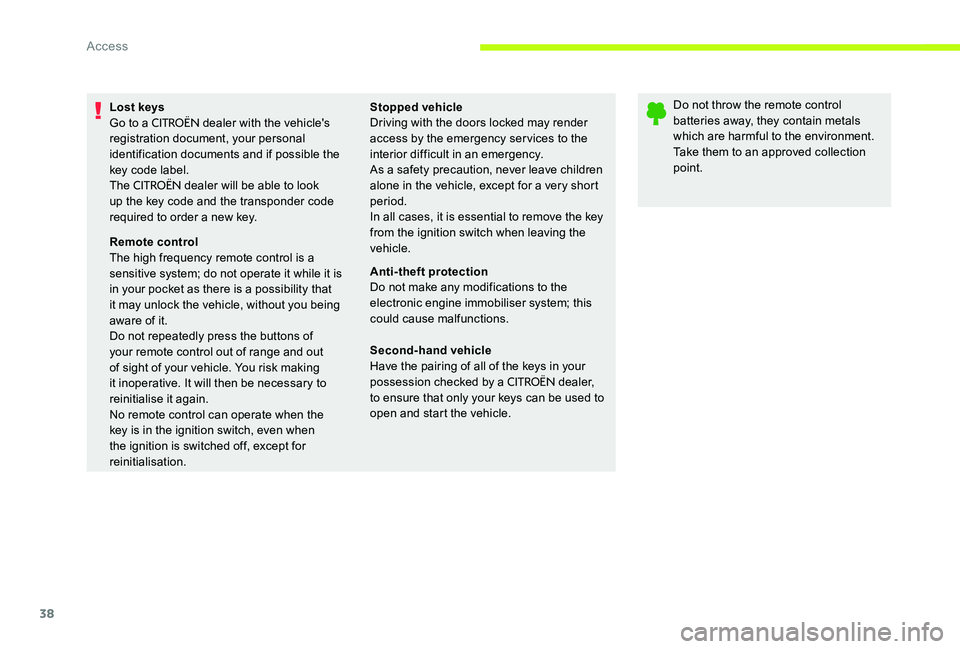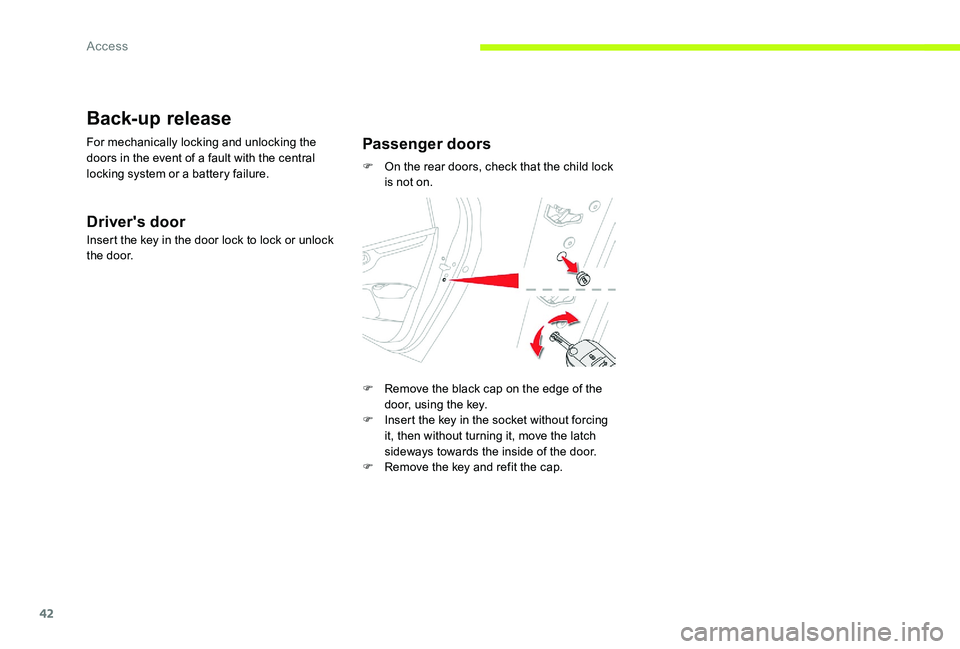lock CITROEN C-ELYSÉE 2017 Handbook (in English)
[x] Cancel search | Manufacturer: CITROEN, Model Year: 2017, Model line: C-ELYSÉE, Model: CITROEN C-ELYSÉE 2017Pages: 306, PDF Size: 9.34 MB
Page 40 of 306

38
Lost keys
Go to a CITROËN dealer with the vehicle's
registration document, your personal
identification documents and if possible the
key code label.
The
CITROËN dealer will be able to look
up the key code and the transponder code
required to order a new key.
Remote control
The high frequency remote control is a
sensitive system; do not operate it while it is
in your pocket as there is a possibility that
it may unlock the vehicle, without you being
aware of it.
Do not repeatedly press the buttons of
your remote control out of range and out
of sight of your vehicle. You risk making
it inoperative. It will then be necessary to
reinitialise it again.
No remote control can operate when the
key is in the ignition switch, even when
the ignition is switched off, except for
reinitialisation. Stopped vehicle
Driving with the doors locked may render
access by the emergency services to the
interior difficult in an emergency.
As a safety precaution, never leave children
alone in the vehicle, except for a very short
period.
In all cases, it is essential to remove the key
from the ignition switch when leaving the
vehicle.
Anti-theft protection
Do not make any modifications to the
electronic engine immobiliser system; this
could cause malfunctions.
Second-hand vehicle
Have the pairing of all of the keys in your
possession checked by a
CITROËN dealer,
to ensure that only your keys can be used to
open and start the vehicle. Do not throw the remote control
batteries away, they contain metals
which are harmful to the environment.
Take them to an approved collection
point.
Access
Page 41 of 306

39
Alarm
Perimeter protection
The system checks for opening of the vehicle.
The alarm is triggered if anyone tries to open a
door, the boot, the bonnet...Self-protection function
The system checks for the putting out of
service of its components.
The alarm is triggered if the battery, the
central control or the siren wiring are put
out of service or damaged.
For all work on the alarm system, contact
a
CITROËN dealer or a qualified workshop.
Locking the vehicle
with alarm
Activation
F Turn the vehicle off and exit.
Deactivation
F Press the unlocking button on the remote control.
F
P
ress the locking button on the
remote control.
The alarm is activated: an indicator
light in the switch panel to the left of
the steering wheel flashes once per
second.
The alarm is deactivated: the
indicator lamp goes off.
Theft and break-in protection and deterrent
system. It provides perimeter protection as well
as a self-protection function.
The perimeter protection is activated 5 seconds
after pressing the locking button on the remote
control.
If an opening (door, boot...) is not closed
fully, the vehicle is not locked but the alarm is
activated.
2
Access
Page 42 of 306

40
Triggering of the alarm
This is indicated by sounding of the siren and
flashing of the direction indicators for thirty
seconds.When the vehicle is unlocked using
the remote control, rapid flashing of
the indicator lamp informs you that
the alarm was triggered during your
absence. Upon ignition, this flashing
stops immediately.
Locking the vehicle without
activating the alarm
F Lock the vehicle using the key.
Failure of the remote control
Operating fault
When the ignition is switched on, continuous
illumination of the indicator light indicates a
fault with the system.
Have it checked by a
CITROËN dealer or a
qualified workshop. To deactivate the monitoring functions:
F
U
nlock the vehicle using the key.
F
O
pen the door; this sets off the alarm.
F
S
witch on the ignition; this stops the alarm.
Access
Page 43 of 306

41
Doors
Opening
From outsideFrom inside
Closing
F After unlocking the vehicle using the
remote control or the key, pull the door
handle. F
P ull the interior opening control for the
door. This action unlocks completely the
vehicle. When a door is not closed correctly:
-
w
hen the engine is running
,
this warning light comes on,
accompanied by a message in
the multifunction screen for a few
seconds,
-
w
hen the vehicle is moving
(speed higher than 6 mph
(10 km/h)), this warning light
comes on, accompanied by an
audible signal and a message in
the multifunction screen for a few
seconds.
2
Access
Page 44 of 306

42
Back-up release
For mechanically locking and unlocking the
doors in the event of a fault with the central
locking system or a battery failure.
Driver's door
Insert the key in the door lock to lock or unlock
the door.
Passenger doors
F On the rear doors, check that the child lock is not on.
F
R
emove the black cap on the edge of the
door, using the key.
F
I
nsert the key in the socket without forcing
it, then without turning it, move the latch
sideways towards the inside of the door.
F
R
emove the key and refit the cap.
Access
Page 45 of 306

43
Boot
Opening
Unlocking and releasing the boot
using the remote control
F Hold the centre button on the remote control down for more
than one second.
Releasing the boot from
the inside Opening the boot
F Raise the boot lid to its fully open position.
Closing
F Lower the boot lid using one of the interior
grab handles.
F
T
hen press the boot to close it.
If the tailgate is not fully closed: -
w
hen the engine is running ,
this warning light comes on,
accompanied by a message in
the multifunction screen for a few
seconds,
-
w
hen the vehicle is moving
(speed higher than 6 mph
(10
km/h)), this warning light
comes on, accompanied by an
audible signal and a message in
the multifunction screen for a few
seconds.
The boot lid is released and opens slightly.
F
P
ress the boot opening button located on
the left of the dashboard.
The boot lid is released and opens slightly.
2
Access
Page 46 of 306

44
Back-up release
System for mechanically unlocking the boot in
the event of a battery or central locking fault.
Unlocking
F Fold back the rear seats to gain access to the lock from inside the boot.
F
I
nsert a small screwdriver into hole A of the
lock to unlock the tailgate.
If your vehicle is fitted with a fixed bench
seat, contact a
CITROËN dealer or a
qualified workshop.
Locking / unlocking from inside
F Press this button to lock or unlock the doors and boot.
If one of the doors is open, the centralised
locking did not work.
Locking from outside
When the vehicle is locked from outside,
the button does not work.
F
T
o unlock the vehicle, pull the interior
door lever.
Automatic central locking
of the doors
The doors can lock automatically while driving
(speed above 6 mph [10 km/h]).
Driving with the doors locked may render
access by the emergency services to the
interior difficult in an emergency. F
T
o activate or deactivate this
function (activated by default),
press this button until a buzzer
sounds and/or a message
appears in the screen.
Access
Page 52 of 306

50
Steering wheel adjustment
F When stationary, lower the control lever
to release the steering wheel adjustment
mechanism.
F
A
djust the height to suit your driving
position.
F
P
ull the control lever to lock the steering
wheel adjustment mechanism.
As a safety precaution, these operations
should only be carried out while the
vehicle is stationary.
Mirrors
Door mirrors
Each fitted with an adjustable mirror glass
permitting the lateral rearward vision necessary
for overtaking or parking. They can also be
folded for parking in confined spaces.
As a safety measure, the mirrors should
be adjusted to reduce the "blind spots".
Demisting - Defrosting
Demisting-defrosting of the door
mirrors operates with the engine
running, by switching on the heated
rear screen.
For more information on Demisting and
defrosting the rear screen , refer to the
corresponding section.
Manual model
Adjustment
F Operate the lever in the four directions to adjust the angle of the mirror glass.
Folding
F Fold the mirror manually to protect it when the vehicle is parked.
Unfolding
F Unfold it before moving off again.
Ease of use and comfort
Page 71 of 306

69
Courtesy lights
ACourtesy lights
B Map reading lights
Front and rear courtesy lights
In permanent lighting mode, the lighting
time varies according to the circumstances:
-
W
hen the ignition is off, approximately
ten minutes.
-
I
n energy savings mode, approximately
thirty seconds.
-
W
hen the engine is running, no limit.
Front map reading lights
F With the ignition on, press the corresponding switch.
In this position, the courtesy light
comes on gradually:
- When unlocking the vehicle.
-
W hen the key is removed from the ignition
switch.
-
W
hen opening a door.
-
W
hen actuating the locking button on the
remote control in order to locate your vehicle.
It switches off gradually:
-
W
hen locking the vehicle.
-
W
hen the ignition is switched on.
-
3
0 seconds after the last door is closed.Permanently off.
Permanent lighting.
4
Lighting and visibility
Page 79 of 306

77
Electronic stability programme (ESC)
Electronic Stability Programming including the
following systems:
-
a
nti-lock braking system (ABS) and
electronic brake force distribution (EBFD),
-
em
ergency braking assistance (EBA),
-
w
heel anti-slip regulation (ASR) or traction
control,
-
d
ynamic stability control (DSC).
Definitions
Anti-lock braking system (ABS)
and electronic brake force
distribution (EBFD)
These systems improve the stability and
manoeuvrability of your vehicle when braking
and contribute towards improved control in
corners, in particular on poor or slippery road
surfaces.
The ABS prevents wheel lock in the event of
emergency braking.
The electronic brake force distribution system
manages the braking pressure wheel by wheel.
Emergency braking assistance
In an emergency, this system enables you to
reach the optimum braking pressure more
quickly and therefore reduce the stopping
distance.
It is triggered in relation to the speed at which
the brake pedal is pressed. The effect of this is
a reduction in the resistance of the pedal and
an increase in braking efficiency.
Anti-slip regulation (ASR)
This system optimises traction in order to
avoid wheel slip by acting on the brakes of
the driving wheels and on the engine. It also
improves the directional stability of the vehicle
on acceleration.
Dynamic stability control (DSC)
If there is a difference between the path
followed by the vehicle and that required by the
driver, this system monitors each wheel and
automatically acts on the brake of one or more
wheels and on the engine to return the vehicle
to the required path, within the limits of the laws
of physics.
Anti-lock braking system
(ABS) and electronic brake
force distribution (EBFD)
The fixed illumination of this warning
lamp signals that there is a fault with
the ABS.
The vehicle retains conventional braking. Drive
carefully at moderate speed.
Contact a
CITROËN dealer or a qualified
workshop as soon as possible.
Illumination of this warning lamp,
coupled with the STOP and ABS
warning lamps, accompanied by
the display of a message and an
audible signal, signals that there is a
fault with the electronic brake force
distribution (EBFD).
You must stop as soon as it is safe to do so.
Call on a
CITROËN dealer or a qualified
workshop.
5
Safety